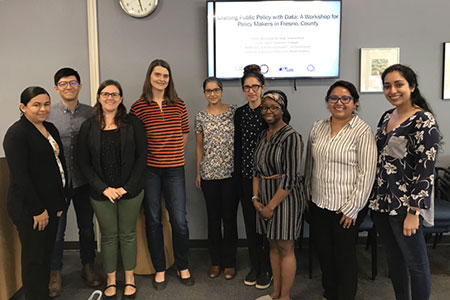UC San Diego Researchers Connect Premature Births to Possible Causes in Central California
New interactive map will show neighborhoods with low to high rates of premature births and potential drivers
By:
- Xochitl Rojas-Rocha
Published Date
By:
- Xochitl Rojas-Rocha
Share This:
Article Content
A research team led by UC San Diego has created an interactive map of preterm births — births before 37 weeks of gestation — and potential environmental and social drivers across Fresno County in Central California. Fresno has one of the highest rates of preterm birth in the state. Their findings may increase discussion surrounding preterm birth, and help local officials implement policies that target stressors affecting specific demographics. The work is a partnership between the Qualcomm Institute (QI) at UC San Diego and UC San Francisco’s California Preterm Birth Initiative (PTBi).

A team of UC San Diego researchers has mapped out rates and possible causes of preterm birth (birth before 37 weeks of gestation) in Fresno. They will reveal a similar map for the San Francisco and Oakland areas on Oct. 21. (Photo credit iStock: Shironosov)
Under study lead Marta Jankowska, research analyst Jessica Block and postdoctoral scholar Jiue-An Yang, all at QI, the team worked closely with the Fresno community, including mothers who had given birth prematurely, to identify possible causes. Their finished product is an interactive, online mapping tool that provides Fresno’s public and policymakers with visualizations of neighborhoods with low to high rates of preterm birth, compared to stressors in the surrounding area. The team will share this tool, unveil a similar interactive map for the San Francisco and Oakland areas, and teach participants to build their own at PTBi’s next Collaboratory meeting on Monday, October 21 in Oakland, California.
“Geospatial exploratory data analysis is a really useful tool set that could help researchers and stakeholders study preterm birth,” said Jankowska. “We hope that being able to visualize patterns through this user-friendly interactive site will support the Fresno community’s understanding of what might drive preterm births, and take action.”
For a significant number of women living in Fresno, giving birth prematurely can have a heavy emotional and physical toll. Babies born prematurely have a higher risk of death or disability, including developmental delays, and can experience negative health consequences later in life.
At the direction of PTBi and partners in the local community, the QI team examined state-provided data on Fresno’s preterm birth rates and open-source data of potential drivers in the natural and manmade environment. Possible drivers included the availability of health care and insurance coverage, demographic and socioeconomic factors, pollution, health risks, food environment and environmental features like open space or access to parks.

Qualcomm Institute researchers (starting second from left) Jay Yang, Jessica Block and Marta Jankowska pose with colleagues at a Collaboratory meeting in April in Fresno of the California Preterm Birth Initiative.
Using data analysis and open-source geospatial mapping software, the researchers transformed the data into an interactive web map that allows the user to view rates of preterm birth across rural, suburban and urban areas. On an adjacent screen, the viewer can compare this map with another showing the neighborhoods’ demographics, socioeconomics, pollution and more.
The research in Fresno has already highlighted some interesting trends. In a study published with the Journal of Epidemiological Research in fall 2018, PTBi researchers found that black women and women with infections, hypertension, diabetes, previous preterm deliveries or fewer than six months between pregnancies had a higher risk of delivering prematurely, regardless of where they lived. Conversely, women who accessed prenatal health care more frequently and who participated in the Women, Infants, and Children Program (WIC) were less likely to give birth prematurely.
That can be critical in an economically depressed region like Fresno, where many families work in agriculture. Competition for access to a quality obstetrician can be fierce, says Block. She still remembers the experience of one mother who decided to leave the care of an obstetrician she felt was verbally abusive. Other women struggle with serious health issues and need expert care, as in the case of a mother with failed kidneys.
Although previous studies have identified similar correlations between risk of preterm birth and income, illness and ethnicity, the new application provides community leaders with a visual tool to understand how each factor affects specific neighborhoods. Armed with this information, policy makers can devise a more targeted approach to tackling local issues in the county. The approach may prove helpful to others looking to enact change in their own communities.
“It’s one of those things where you go ‘of course,’ but to actually see it mapped out in front of you is a whole new ballgame,” said Jankowska.
Jankowska, Block and Yang recently published their workflow in the journal Preventing Chronic Disease. In the future, they plan to expand their modeling efforts to map preterm birth rates in San Diego, southern California.
The UC San Francisco California Preterm Birth Initiative is an interdisciplinary research enterprise dedicated to eliminating racial disparities in preterm birth and improving health outcomes for babies born too soon, through research, partnerships and education grounded in community wisdom. Other partners involved in the mapping tool research include the UC San Diego School of Medicine, Department of Pediatrics; the UC San Francisco Department of Epidemiology and Biostatistics and Department of Obstetrics and Gynecology; the Central Valley Health Policy Institute and the San Francisco Department of Public Health.
Share This:
You May Also Like
UC San Diego is Strengthening U.S. Semiconductor Innovation and Workforce Development
Technology & EngineeringStay in the Know
Keep up with all the latest from UC San Diego. Subscribe to the newsletter today.



